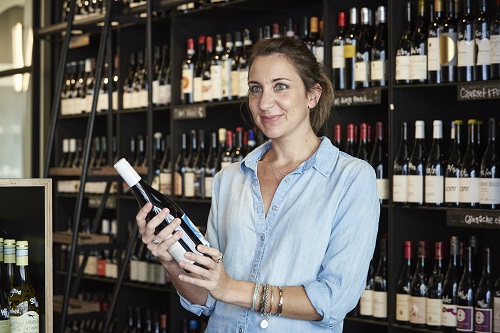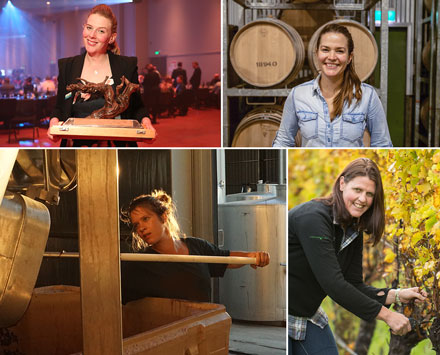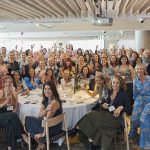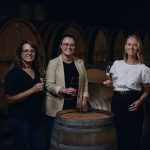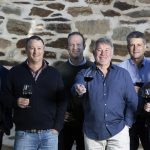Today is International Women’s Day and the official theme of IWD2019 is #BalanceforBetter: “a balanced world is a better world”.
This theme is particularly salient in the wine industry. It’s estimated 50% of oenology and viticulture graduates are female, but only 10% of those female graduates attain leadership roles once they’re a part of the industry.
When we tell our daughters they can grow up to be anything they want to be, we have to believe it too. We have to do the work today to improve the world for future generations. With that in mind, as the official International Women’s Day website asks, how can YOU help forge a more gender-balanced world? “Celebrate women’s achievement. Raise awareness against bias. Take action for equality”
A great way to celebrate women’s achievements in the industry while also taking action for equality, is to support the Australian Women in Wine Awards’ venture, ‘Hear me roar’; the world’s first wine produced by women where 100% of profits go to assist women to succeed in their chosen profession in the wine industry. Sourced and blended by four Australian female winemakers, this wine is a great way to put your money where your mouth is and support the future of women in wine.
We came across some eye-opening information when producing Daily Wine News recently, courtesy of US wine blog, Winespeed: Karen MacNeil wrote, “I surveyed 160 women in the wine industry and asked them the following: In the wine industry, women remain underrepresented in most professional roles and at most levels, from entry to executive. What are the biggest barriers to women’s advancement? The top response for the biggest barrier to women’s advancement: “The perception by men that the wine workplace is already equitable when in fact it isn’t”. Number 2 was: “Men intrinsically feel more comfortable interacting with and promoting other men”. It’s up to all of us in the wine industry to change this.
In the spirit of celebrating women’s achievement, we collated the profiles of women in wine we’ve published in the last year, including a snippet of an article to come from our soon-to-be-released March issue. The editorial department of Winetitles Media is one that proudly represents and celebrates girl power: Sonya Logan is editor of both Winetitles publications, Grapegrower & Winemaker and the Wine & Viticulture Journal. Sonya started working at Winetitles 25 years ago as a journalist, and worked her way up to editor. The articles you’re about to read were written by former and current journalists Chloe Szentpeteri and Eleanor Danenberg. The following articles highlight the hard work and determination of women in the Australian and New Zealand wine industries, and we hope their stories inspire you today and every day.
A viticulturist with true vigour
Success story: Emma Taylor
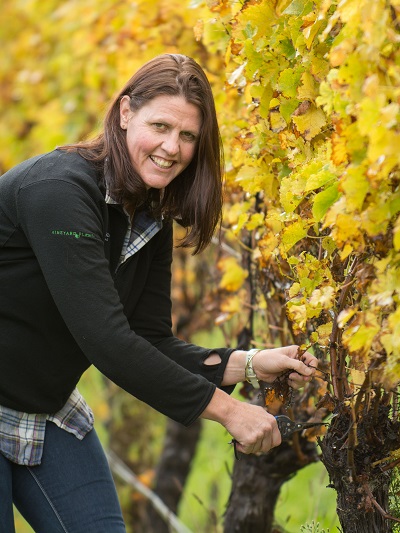
Emma Taylor is never one to shy from a challenge. Ambitious, dedicated and hungry for knowledge, she has grown her strengths across many areas of viticulture, and now spends her days as the nursery viticulturist at Hawke’s Bay winery, Villa Maria. Chloe Szentpeteri spoke to the experienced New Zealander, to learn more of her story.
Emma Taylor is the embodiment of a success story. The 40-year-old was born in Auckland and has made her way through New Zealand’s wine regions in her various viticultural roles.
Her first employer was Villa Maria, New Zealand’s most awarded winery, and she loved it so much she never left.
Starting her career as a cadet, she quickly earned her stripes and climbed the ranks from research viticulturist, to company viticulturist, through to project manager and finally to her current role, nursery viticulturist of Villa Maria’s Hawke’s Bay nursery, Vineyard Plants.
But Taylor’s career isn’t the only notable achievement. The mother of three also holds two prestigious titles and has helped in research development for trials of vine health and disease management.
Mastering the vines
Taylor was studying an undergraduate degree in physical geology, and a Master of Science at Otago University, when she was searching for a topic to do her thesis on.
It was the guidance of Country Calendar – a TVNZ programme that covers rural life – that happened to be focussing on the organic Milton Vineyard and Winery in Gisborne, which has since become biodynamic.
“And I thought that’s what I want to do, I want to look at the difference between organic vineyards and conventional,” Taylor exclaimed.
A complex topic, Taylor said she is still trying to grapple with the answers to those questions now.
So instead her professor suggested to look at copper accumulations and organic versus non-organic vineyards.
Peak industry body, New Zealand Winegrowers, funded her project and she took the opportunity to explore the regions.
“I travelled all around New Zealand to the different wineries and looked at all the different soils and sampled them,” Taylor explained.
She said the industry insight was enough to plant the seed of her career, which has blossomed ever since.
“I met all the people in New Zealand and that was a few years ago at the end of 1999/2000.
“The industry was starting to boom and was full of energetic and innovative people and I wanted to be a part of it,” she said.
As a New Zealand tradition, Taylor did her overseas experience (more commonly referred to as OE) in viticulture, and travelled throughout the UK before returning to a short term contract at Villa Maria. “I had my masters and I obviously had no viticultural knowledge but I just knew that I wanted to get in there and I knew applied copper and that’s about it.
“Villa was looking for a research viticulturist at that time, which was going to sync with their research program and I didn’t get that role but they took me on a six month contract initially to help out in Hawke’s Bay during vintage and doing all the technical stuff like bunch weights, yield estimation and more,” she explained.
And the tie to Villa Maria didn’t stop there. Taylor was offered a year-long cadetship which she described as ‘amazing, real-life training’.
“They took me through all aspects of the company. I went and joined sales for six weeks and I worked in the cellar for six weeks and then that year I did all the yield estimates in Gisborne, Hawke’s Bay and Marlborough, which is where we used to be,” she said.
“So I moved around the country and the company lots, understanding everything really. It gives you such a broad understanding of the whole process, right from the vines, to the nursery and the bottom line to sales.”
After the cadetship, Taylor became the research viticulturist, offering technical support, doing yield estimates and coordinating with other technical officers throughout the regions.
Her career was temporarily interrupted by the desire to travel and she left with her husband to work in logistics in England.
But to Taylor’s surprise, one day she received a call from the founder of Villa Maria, George Fistonich, who offered her the top role of company viticulturist. And, of course, she said yes.
Taylor came back for the first vintage while her husband continued travelling in the UK.
“I worked a few months and then finished travelling in the UK and finally came back fulltime.
“I had that company viticulturist role for four years until I had my first child in 2007 and it was while I was on maternity leave with my first child that I entered the young viticulturist competitions and the young horticulturist of the year competition, she explained.
“And then I won.”
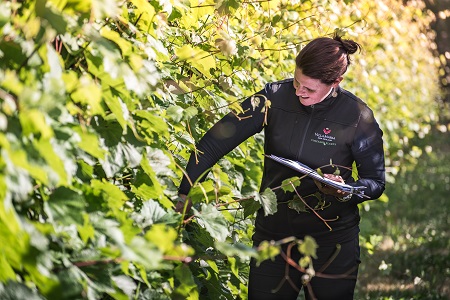
Picture: Villa Maria’s Hawke’s Bay nursery and vineyard plants
Awards and achievements
The competitions were in their second year, and anyone interested needed to apply firstly for the regional competition.
And when Taylor found out she was pregnant, she knew the competition would be worth a try.
“In the wine industry, awards mean a lot, especially for winemakers, they get a lot of accolades as well they should, but there’s not that much out there for viticulturists.”
“I thought, if I don’t step up for this I’m going to regret it, and that first year I was newly pregnant and I didn’t really want to run around putting posts in the ground and scrambling around under wires,” Taylor laughed.
“I entered the Hawke’s Bay competition and I was successful, although I think that was one of the hardest competitions I ever did because you’re really going against your peers and everyone knows the region the best.”
After her first round win, Taylor went on to the national competition where contestants competed against all the other regional finalists and took the title of the 2007 ‘Young Viticulturist of the Year’.
And why stop there? Taylor entered the young horticulturist competition, against fruit and vegetable growers, forestry and a range of other industries, and won that too.
“It was pretty cool and it was a really great way to keep my motivation up,” she said.
“As I was on maternity leave I didn’t want people to think that now that I’d gone and had a baby that would be it for me.
“I wanted to keep a hand in the industry and a finger in the pie, and it was a way to keep current while I was on leave.”
After Taylor won the young viticulturist competition, she decided to coordinate it for eight years and during that time she has seen the industry evolve and technology grow.
Reflecting on her experience as coordinator, Taylor said she found the responses to competition questions had changed.
Once upon a time, seven out of eight contestants would respond to a question on sprays with a conventional spray programme. Now, she said every single contestant could provide a conventional and organic method and use both as an example.
“That knowledge and growth in the softer chemicals has really grown in viticultural awareness, the whole industry is growing,” Taylor said.
Present day
After having her second and third children, Taylor no longer wanted to work in the company viticulturist role that demanded so much travel.
Instead, she became the nursery viticulturist four years ago and remains in that role to this day… With a little research on the side.
“I was hungry for knowledge on top of doing my projects, so outside of work I also sat on the New Zealand Winegrower research committee and was involved in a lot of the big research programmes like the virus elimination project and the grapevine trunk disease project among others.
“One of the biggest challenges we have in the nursery industry is managing trunk disease. There’s a lot of pressure on the nurseries and there’s a perception that nurseries are spreading trunk diseases,” Taylor explained.
The New Zealand Vine Industry Nursery Association (VINA) includes all the nursery suppliers in the industry and works in collaboration with New Zealand Winegrowers on grafts and grapevine standards.
Two years ago the organisations updated the grafts and grapevines standards to incorporate vine health, which elaborates on how many hygiene practices nurseries follow to ensure the risk of trunk disease spread is minimal.
“New Zealand nurseries, because there’s a smaller number of us, we’re quite scientifically aware of the latest research out there,” Taylor said.
“We have recently undertaken our own research looking at testing the effects of hot water treatments on trunk disease and vines compared to no hot water treatment, and what those trunk disease levels were and we found that hot water treatments didn’t make any difference to the bacterial or fungal disease counts in the vine.”
This trial is ongoing and will continue as a long-term method of data retrieval for hot water treatments as the vines grow older.
With a ‘perception’ that nurseries spread trunk vine diseases, Taylor said the dedication from New Zealand Winegrowers is important to ensure awareness of trunk disease and what tools are available to understand it and prevent it in a nursery.
Taylor said another issue is the lack of a standardised measurement for trunk vine disease.
“The VINA project was developing some qPCR technology [to detect DNA sequences]to try and quantify how much disease we had and it’s got that methodology out there which requires fine tuning over time,” she said.
“I know there’s some research going in Marlborough looking at how to quantify it and measure trunk disease and it’s happening globally as well.
“There’s also a vineyard ecosystem project happening and it’s looking at the impact of spray on Botrytis and this research is looking at the impact it’s having on your soil, and the overall vine health and if it affects the water uptake of your vines. It’s really interesting,” she added.
A lighter note
With so much research and nursery duties to keep her busy, Taylor said no day is the same.
“I enjoy the variety. If you’re a viticulturist or winemaker every vintage is different and there’s something different about every season, whether it’s the heat you’ve had or the rain or the wind. “In the nursery, seasonality can have a huge impact and it means no two days are the same.”
Taylor said her career and enjoyment in her various roles wouldn’t have been possible without George Fistonich, Villa Maria’s founder.
“His insights are so spot on and his ability to innovate and to let people play to their strengths. He’s a pioneer,” she explained. “He started Villa Maria over 50 years ago. It’s a long time and he did a lot of ‘firsts’ for New Zealand during that time.”
When asked if she drinks wine, Taylor responded with a laugh.
“Of course I drink wine. I do like the Te Awa Leftfield Albarino. It’s a relatively new variety in New Zealand and I’ve yet to hear of someone who doesn’t like it.”
Taylor has worked hard for the opportunities throughout her life, and certainly hopes they keep on coming.
“I’ve been very lucky because even though I’ve stayed within the one company in New Zealand I’ve had a lot of opportunity and a lot of different roles within Villa Maria and so my next plan is to not miss out on the next opportunity.
And never shy from a challenge, she finished with a promise.
“I’ll keep my eyes and ears open so I can keep being passionate.”
This article was originally published in the April 2018 Grapegrower & Winemaker magazine.
A wandering winemaker
Young Gun: Kate Sturgess
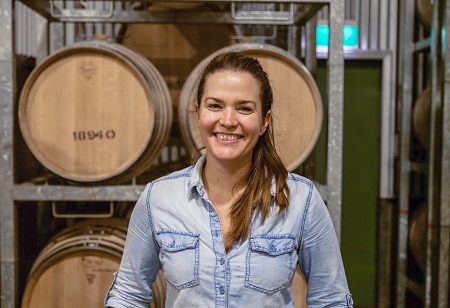
A winemaker worthy of the title, Kate Sturgess has been in many a winery from across Australia and overseas. Now confident and comfortable in her current role, she looks back on her progress as a stepping stone to her success. Chloe Szentpeteri shares her story.
Kate Sturgess entered her 30s just weeks ago with an impressive portfolio and some worldly experiences worth envying. With several winemaking and vintage roles up her sleeve, it’s no wonder she’s now working for Brokenwood Wines in the Hunter Valley.
Originally from Queensland, she’s come a long way both across Australia and abroad to gain the knowledge that has informed her current career path.
Sturgess was born in Brisbane from a long line of Aussies, dating back to when British convicts first set foot on Australian soil.
Hailing from a state where wineries are but odd dots on the map, she said it’s not uncommon that people ask how she ended up in wine, although the story is quite simple.
Sturgess went to a school structured to help students identify future career paths, so she began to choose the right subjects from year 10 onwards, and after scanning university books, decided three things: she would be a veterinarian, architect or a winemaker.
After further investigation, she knew where her heart lay. “People in the wine industry stay in the wine industry and are basically in it until they die,” Sturgess laughed. “They just love it and that sort of passion was what I was looking for, so I took a bit of a gamble and moved down to Adelaide to study at the University of Adelaide’s Waite Campus.”
Sturgess was lucky enough to enrol in the first year of a revised bachelor of viticulture and oenology, which included both sides of the coin, unlike previous course options where students had to choose one or the other.
She began her study in 2008 and thanks to the support of fellow students, never looked back.
“I loved it and was pretty lucky. In my year at uni I had quite a few peers who are still very involved in the wine industry and either came from families who were involved in the wine industry before or were similarly passionate about
what they were doing, so I have a fair network of people that I can still call on from uni.
“And I think that helped a lot from being able to then feel comfortable in the industry.”
In her last year of study, Sturgess completed her course industry experience at Wirra Wirra in SA’s McLaren Vale and enjoyed it so much, she went back for a vintage and then worked for a further six months.
But what’s life without a little travel?
Sturgess ventured around Spain and Italy for several months, accompanied by a friend from university who just so happened to work a vintage at Italy’s Abruzzo winery.
After a time, she continued her travels in Germany until her funds were in dire need of a refill.
After chatting with another friend who had studied a post-graduate in wine marketing, she was offered work at their family winery in Canada.
“I didn’t want to go home yet so I went over and did a vintage in Okanagan in Culmina Estate with the Triggs family,” Sturgess said.
“I was there from October until the start of December and then came home for Christmas.”
But the career call still beckoned, so Sturgess moved to the Hunter Valley in NSW, working a vintage for De Iuliis Wines before moving on to Mt Langi Ghiran in Victoria’s Grampians region, where she moved in with winemaking pal, Melanie Chester.
Receiving advice from her former housemate and woman in wine icon, Samantha Connew, Sturgess soon realised she needed to form roots at a winery in order for her career to grow.
“Basically she kicked me up the bum and said ‘what are you doing, are you just going to keep doing vintages for the rest of your life or are you going to get serious and get a real job’?” Sturgess laughed.
And so thanks to Connew, assistant winemaker and winemaker positions kept rolling in until Sturgess landed a role at Balnaves in SA’s Coonawarra.
“So I applied for that and got the job and was assistant winemaker there for two years.”
While she was there, the position at Brokenwood popped up—somewhere she had always thought of as the place to be for work.
“They’ve got a pretty cool attitude towards making good wine and drinking good wine so I applied for the gig and managed to convince them to hire me and I’ve been here for three years.
“It’s been good to see around the country and I loved working in Coonawarra, I think it’s similar to the Hunter, the wine community in the region is very strong and certainly they want to keep good people, and it’s quite fun trying to convince people to drink exceptional wines that they don’t necessarily normally opt for,” Sturgess admitted.
She said pushing boundaries and encouraging wine consumers to try new things was a fun part of the job, especially when it came to Coonawarra’s famed terra rossa Cabernets.
“So Cabernet is a bit out of fashion at the moment, and bringing that back into the limelight and being like, ‘why aren’t you drinking this wine?’, well that was quite fun for me and in the Hunter, Semillon is a bit similar and it’s sort of like ‘why aren’t more people drinking this, it’s great!’. So it’s a bit of a challenge as well as getting to make the best wines that we can.”
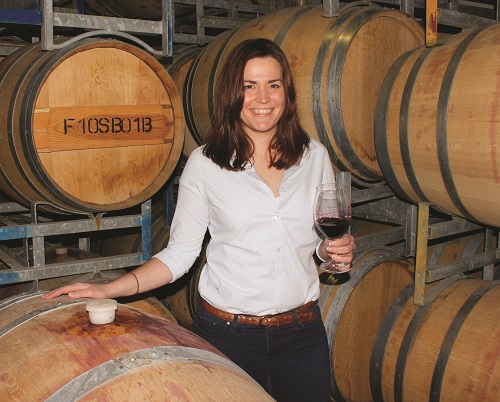
What makes a winemaker?
Since starting at Brokenwood Wines, Sturgess has learnt many lessons alongside chief winemaker, Iain Riggs, and senior winemaker, Stuart Hordern. “Riggsy has been here since 1982 and inherently just knows the fruit, the vineyards, what the wines should look like, the vintages, he can tell you ‘this one looks like the 1993 vintage’ based on the rainfall and weather data and things,” Sturgess mused.
“He’s just an amalgamation of a lot of knowledge and then Stu is obviously the main winemaker in terms of day to day in the winery and then during vintage his main role is doing the picking decisions.
“Because that’s the most important decision you make in the life of any wine so he’s responsible for that and my home base is the winery and if he’s on the road he’ll let me know what’s coming in and I’ll organise and try not to screw it up.”
Sturgess said she has significant responsibility for what her role is, and admits she is lucky to share trust in blending decisions for final wines.
Importantly, she said her opinion isn’t immediately written off, which could be expected for some assistant winemakers who are still learning.
And many young winemakers have made their break at Brokenwood Wines, with some considerable names amongst alumni that have worked at the winery in the past.
One thing Sturgess has noticed in particular is the management skills and time that Brokenwood staff put in to help winemakers such as herself.
“There’s no ego, it’s all about just making the best wines that we can which is quite refreshing in the wine industry, and also as a girl is quite useful because I wouldn’t be there if they didn’t value my opinion,” she said.
“I think the nice thing about the wine industry is it’s quite a collegiate industry. You can’t go to any wine region and not find someone who doesn’t know someone that you also know, so within that, if you’re doing the right thing by staff and by the people that work with you, you get a good reputation.
“So people are choosing to do the right thing because it is the right thing but also because there’s no real secrets in the industry and so if you don’t treat people right then people will know.”
And the wine industry is certainly changing, bearing this and more in mind as key industry bodies from Australia and New Zealand have shown a conscious effort to ensure all facets of winemaking are equally available and accessible to both males and females.
Australia has come a long way in reforming the wine industry and establishing balance, but it wasn’t always so.
“I think historically probably they [women] were disadvantaged,” Sturgess said.
She also said that gender equality has become somewhat of a trend.
“It can be certainly advantageous but I think once you’re hired, you have to keep that job so no matter whether it’s helping you or hindering you, you still have to be able to perform that role.
“I think that the industry is certainly a lot more open to trying to encourage female involvement now and there’s a lot more channels where you can talk to someone who’s done it all before.”
Sturgess has had ongoing support from iconic women in the wine industry, including the likes of Samantha Connew, founder of Stargazer wine; Sarah Crowe, James Halliday 2017 Winemaker of the Year; Liz Silkman, co-owner of Silkman Wines; and Gwyn Olsen, head winemaker at Pepper Tree Wines and several times awardee winemaker and scholar.
And Sturgess said these ‘strong female figures’ are just a phone call away.
But even with support from colleagues, Sturgess said it’s about finding the places that you want to work for and who are ready to accept change in the industry.
“And families are changing because some families only have girls. So all of a sudden even if it has been the most maledominated company in the industry, it’s forced to accept that, that’s not how it’s going to be forever and that kind of opens people’s eyes to the fact that we can get as much done as boys.
“Restaurants and sommeliers are encouraging women coming through the ranks and the whole industry is doing well with that,” Sturgess added.
So how does the wine industry make it sustainable to keep young men and women in the wine industry?
Sturgess said starting a family can be tough when in the wine industry, and life influences can impact the careers of male and female winemakers.
But the issue could start earlier than that.
In her bachelor of viticulture and oenology, 25 students graduated in Sturgess’ year. Four of them were girls.
The fruits of labour
Now that Sturgess is well placed in the industry, and is comfortable with her place in it, Sturgess said she enjoys her role and the many different tasks within it. From vintage, to sampling in the vineyards, tasting the fruit and seeing that processing from start to finish, like so many in the industry say, Sturgess said she enjoys the variety.
And although she’s a gun at what she does, Sturgess has challenges of her own to overcome, starting with the recent purchase of a new home.
“I bought a house at the end of last year and decided to renovate it just prior to vintage so this year it was time management during vintage and how to actually balance a life outside of the winery when you need to be at the winery 12+ hours a day, six or seven days a week,” she said.
In 2017 and 2018, those hours paid off as Brokenwood Wines reported good vintages, with some ‘excellent wine’ in the winery, ready for bottling.
But the most prominent news from Brokenwood Wines is the addition of a new cellar door, restaurant and tasting area, expected to open in December 2018.
With so much happening for Brokenwood Wines within the year, and so much to look forward to in her own role, Sturgess said she is really enjoying her work and isn’t looking for any immediate change.
“They’re such an excellent company so if I can hang about here and develop my skills and whatnot a bit longer then that’s great.
“People always ask me if I want to start making my own wine but I’m terrible at money management so I quite like the reliability of working for a company that has people who are much better than I am to organise things like that, so I can just focus on the actual making of the wine and making the best wine that we can,” she added.
And with Brisbane just a short flight away from the Hunter Valley, her family remain close, her best friends, Melanie Chester and Ben Mullen are on speed dial, and Kate Sturgess is one happy winemaker.
This article was originally published in the July 2018 Grapegrower & Winemaker magazine.
Young Gun: Annabel Bulk
Going green never felt so good
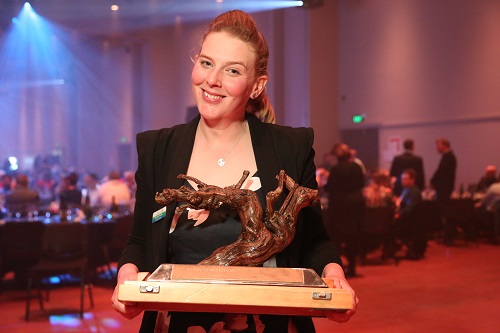
Clean, green and a viticulture machine, 2018 is Annabel Bulk’s year to shine, having recently completed the 2018 Bayer New Zealand Young Viticulturist of the Year competition and coming out on top. However, with another competition to go and a taste for education, this assistant viticulturist is just getting started. Chloe Szentpeteri reports.
A week after placing first in the Bayer New Zealand Young Viticulturist of the Year competition, Annabel Bulk turned 30 giving her yet another reason to celebrate.
After several weeks of hitting the books, performing practical tasks, sitting examinations and undergoing gruelling interviews, her hard work paid off when she was announced the national winner on 30 August.
There are six regional competitions held in New Zealand each year comprising a small group of young, passionate professionals in the wine industry.
Each competitor must display their knowledge of the practical and theoretical aspects of the industry, which includes topics such as tractor driving and maintenance, to wine tasting and trellising.
After that comes interviews, which this year focussed on budgeting and irrigation.
Making it to the semi-finals requires individuals to have a broader understanding of the industry, and to be knowledgeable of their respected wine region.
Only then will a winner proceed to the national finals, which explores the bigger picture of New Zealand wine.
Annabel Bulk said this year’s topics included pests and diseases, pruning and trellising.
“There’s also a big project which goes towards the final, and this year the requirement was completing a comparison of different weeding options in the vineyard, which took up all the time leading to the competition.
“I have to say a huge thank you to the sponsors and supporters who have helped out and surrounded me over the many weeks of the competition. It wouldn’t happen without sponsors so that’s so important — I wouldn’t have got there without support.”
Bulk said she was grateful for the experience and for what she learned during the weeks leading up to the final — and she’s not the only one proud of her success.
Her employer, Felton Road Wines, and its team of 12 voiced their delight at her accomplishment and have expressed plans to further her education and growth at the winery.
“They know that I’m really interested in doing what Emma Taylor has done and continuing to be really involved with the competition now that I won’t compete anymore,” Bulk explained.
Emma Taylor was the 2007 Bayer New Zealand Young Viticulturist of the Year, and continues working with the competition as a judge and mentor.
“They’re very much aware that I love to keep learning and love to keep teaching other people as well. We had a discussion yesterday about how they were going to further me with that and making sure that I still stay up to date with research and other projects that are happening.”
Hungry for more knowledge, Bulk is also preparing for the Bayer New Zealand Young Horticulturist of the Year competition. And having studied horticulture in the early 2000s, she is well equipped for the challenge.
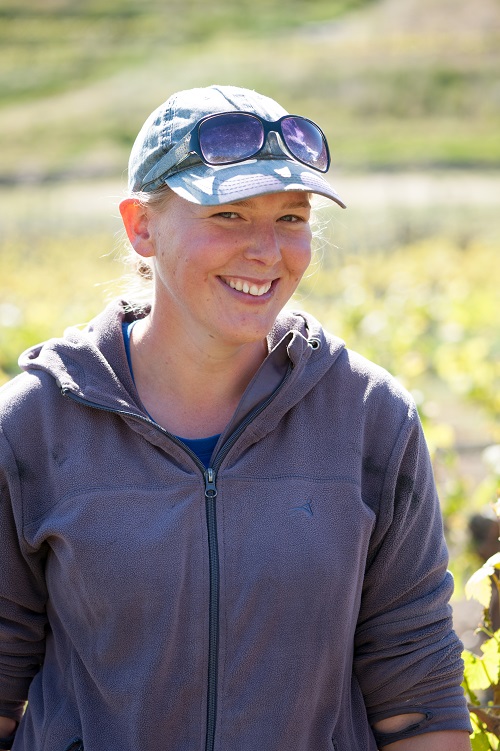
Grass roots
Although she enjoys working in the wine industry immensely, Bulk stumbled upon viticulture rather than sought it out.
As a child, she grew up in Dunedin on the South Island of New Zealand, with two ‘outdoorsy’ parents and a mother who loved gardening, conservation and sustainability.
Following in her footsteps, Bulk did some voluntary work for the National Department of Conservation in her youth, with one thing leading to another until she moved into nursey work, then horticulture and, finally, viticulture.
After studying horticulture, Bulk and her partner decided to focus their skills further and in 2009 entered into a Viticulture and Winemaking Degree at the University of Otago in Dunedin.
“I never really thought I’d end up in the vineyard itself,” Bulk admitted.
“After studying I had been quite into winemaking and wine science but I needed to complete a six week practical in the vineyard to finish off the degree.
“And after that I never looked back and never decided to go back into the winery.”
Bulk applied for a summer role at Felton Road Wines and after six years, she’s still there.
Now an assistant viticulturist, Bulk said there’s not a single thing she loves more than another about her role but if she had to name a few, it’s being outside in the beauty that is Central Otago.
“It’s a beautiful region here so that’s a big draw factor but every season is different so that learning and the ability to teach people and see the passion grow is such a huge part for me as well.
“We get backpackers who have never worked on vines before and they’ll start off a wee bit interested and then all of a sudden they talk about going home and finding vineyards to work on; we’ve had people who will leave here and go back to find their own vineyards,” she mused.
“And they had never thought they were going to end up in the wine industry but they’ve grown to love it and have a passion for it by the time they’ve left here so I think that’s quite amazing to be able to have such a big influence.”
On the other hand, a challenge Bulk is yet to overcome is the administration that comes with a business, namely accounting and planning.
Bulk is one of 12 permanent staff members at Felton Road, which swells to 50 during harvest to work over 32 hectares of vines. Not a day goes by, nor a season, that Bulk doesn’t enjoy her job and all that it entails.
However, on a busy day, or any given day, she doesn’t mind a glass of Chardonnay or two, sometimes paired in winter with knitting, crochet or spinning wool — an oddball hobby she admitted.
“With wine I swing from different things at different times but my favourite varietal is Chardonnay. I love the diversity you can get and very rarely I come across one that I don’t like so it’s my go-to wine. If I don’t know how I’m feeling I’ll go out and get a new Chardonnay to try!”
Reflections
With a prestigious title under her belt and a supportive workplace, Bulk is well on her way to a prosperous career in viticulture.
But not without exploring new territory.
Having holidayed in Europe a few years ago, Bulk and her boyfriend travelled through French and Spanish wine regions, tasting as they went.
Next time they go overseas, Bulk said she plans to build her knowledge of the wine industry, but for the next few months, the young gun will have her hands full with more competitions.
“I’m happy where I am but I want to emphasise the growing and learning for the next stages that are coming. I feel like the competition has given me so much and I want to give so much back. I want to be really involved with the regional competitions here next year and set questions and be available for people who need or want to know more about the industry,” she said.
“That’s the next important thing for me.”
This article was originally published in the October 2018 Grapegrower & Winemaker magazine.
Young Gun: Julia Weirich
Journey into winemaking across the globe no coincidence
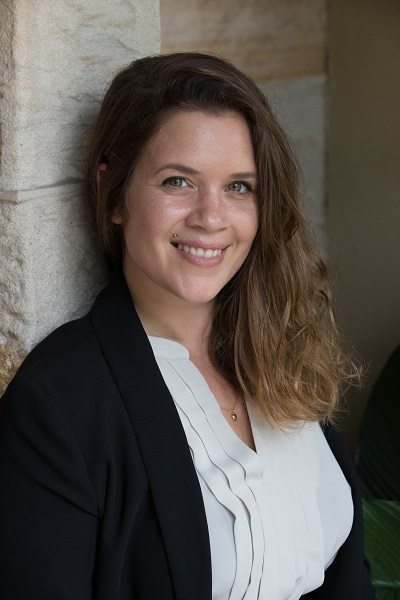
Having worked in wine distribution and made wine, German-born Julia Weirich feels the latter is where her heart beats strongest, writes Eleanor Danenberg
Julia Weirich didn’t come to work in wine through coincidence, as she doesn’t believe in coincidence. “Everything happens for a reason,” she says.
Originally from Germany, she embarked on a journey once finishing her Masters in Industrial Engineering and decided to travel to not only improve her English skills, but also discover the world. After exploring South East Asia for a few months, she landed in Australia with an open mind, curious about the possibilities this country might offer her. Little did Weirich, or Australia, know what was coming.
Weirich and Australia hit it off. After several jobs in different industries “as backpackers do”, the turning point in her career came when Weirich noticed “this tiny little ad” for a marketing position for a wine distribution company, FESQ. That was six years ago, the beginning of Weirich’s wine journey.
The job made perfect sense for Weirich. “I always loved the idea of working with small, family-run businesses, and tangible, premium goods you have a connection with,” she explains, adding, “I loved enjoying wine but at that time I didn’t have an idea about the depth of this field.”
She began the position of marketing coordinator, working with a wide array of domestic wineries of all sizes, and “no clue”, she laughs. Dedication followed discovery, education, in-house training, and the WSET certificates 1-3 over two years. At the end of her WSET 3, Weirich was deliberating whether she should do her diploma or get her hands dirty.
Trusting her gut, she went with the latter. She left FESQ, the workplace that had become like a family to her, and worked at Bass Phillip in South Gippsland for her first vintage.
Phillip Jones a mentor
“Every second is learning,” she recalls. “Phillip Jones [founder and winemaker] became a mentor. After a couple of days I thought, that’s it! I’ve found it! The one thing that sparks my heart and makes me want to dig deeper! To be honest, it’s the most exhausting job I’ve done in my life; I was physically exhausted, but, oh, it was so rewarding.
“We all sit in the same boat, having each other’s backs even in the hardest times, and at the end of the day we all know what we are working for”.
A back-to-back vintage at Yealands, in New Zealand, followed, bringing the experience of the winemaking process on a “slightly bigger scale”.
”I’ve discovered nightshifts are the most confusing thing. At one point I stood in the cellar and was seriously contemplating what time of the day it was. You lose track of time. And a lot of pens,” she laughs.
Next came six weeks of travelling around Italy, spent discovering the wine regions, connecting with winemakers, learning about their approaches and vineyard management systems.
Then came Le Grappin, in Burgundy, for what Weirich calls “another stepping stone in my ‘A-ha’ moment of winemaking”.
She laughs, “It was probably one of the tiniest wineries I’d ever worked in. We had to play Tetris getting everything out of the winery in the morning just to be able to process the grapes, then push everything back in at night.
“I couldn’t be more grateful for the people I met, the brains I was able to pick and the very special memories I share with those beautiful humans. Andrew Nielsen [winemaker and producer of Le Grappin] was a wonderful teacher and showed me a new perspective on winemaking.”
Weirich continued on her path, to Mulderbosch in South Africa, where she experienced yet another facet of the industry.
“Water shortage was something I’ve never experienced before and it was something that put things into perspective. You learn how to be more resourceful and conscious about your work. “Adam [Mulderbosch] and Mick [Craven] have contributed so much to my learning and I look back on my time in South Africa with a big smile.”
Over the course of travelling the world and working harvests in different countries, Weirich always stayed in touch with David Fesq.
“We are friends and kept each other updated on our lives”.
After finishing harvest in Stellenbosch, the opportunity arose to return to FESQ to help build a premium imports portfolio. Australia called Weirich back, the place where she believes has the best work-life balance, where the people are affectionately light-hearted.
She became European wine manager, with FESQ launching the first instalment of its European portfolio at the start of 2018. However, Weirich couldn’t get winemaking out of her head. “I spoke to Dave about my dream and shortly after, things started moving”.
Weirich had previously worked with Simon Cowham and Corey Ryan from Sons of Eden, and they were happy to join the project.
“We sat down and talked, and this is how Brave Souls was born. And from then, it was a very steep learning curve”.
Weirich worked on Brave Souls’ first vintage while working at FESQ, and I asked her how she managed it: “Multitasking!” she answers, laughing. Being flexible and strict time management are paramount. In Weirich’s case, FESQ supported the project, so the company understood her taking time off and working from interstate.
Weirich is still working with FESQ as well as Brave Souls, and is embracing the chaos: “Imagine an octopus with eight arms; that’s me. An octopus under a rainbow…holding eight glasses of wine.”
Brave Souls’ first vintage in the Barossa Valley, which included a 2016 Shiraz, 2017 Riesling, and 2016 Grenache Shiraz Mourvedre, was a success to say the least. The Riesling received 5 Red Stars in the Halliday Wine Companion 2018, The Whaler Shiraz received 96 points, and The Able Seaman GSM a 95 point review.
Weirich laughs recounting the moment of disbelief when she answered the phone and James Halliday himself was on the other line.
“A truly kind person, but it was hard for me to hide my nervousness. I mean, it doesn’t happen every day that you have the honour to speak to such a highly regarded personality in the industry!”
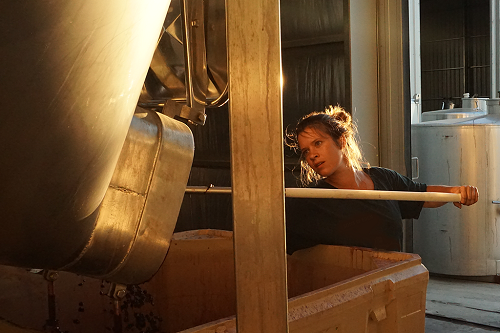
Pinch-me moment
Regarding the pinch-me moment as a career highlight, Weirich affirms, “it just shows whatever it is, if you put your heart towards it and your hard work into it, you will get rewarded”.
Speaking with Weirich for an hour, even just on the phone, her spirit, energy, and passion shine through. I can visualise the sparkle in her eye as she talks about wine.
“Wine for me is something that should bring people together; it should be enjoyed, you feel the soul in the product, you feel the essence of what the land gives, how the winemaker gives love and passion and hard work – you should taste that. I’ve never wanted to make anything else. I love to drink it, I hope other people like to drink it and have a bloody good time with it.”
When asked what’s her favourite wine to make, Weirich struggles to answer.
“For me the beauty is in every variety to bring out the most special part of it and make it, underline the uniqueness of the terroir, of the vintage, what the year brought, what Mother Nature brought. You have a blank canvas in front of you and you’re an artist, you’re trying to paint the most beautiful picture of the harvest.”
If you taste a Brave Souls wine, Weirich doesn’t mind if you can’t find the words to articulate what you taste.
“It’s not about the ‘right’ words. Is it smooth, is it big, does it make your lips stick to your gums, is it mouth covering, is it elevating, is it more like red or a dark blue, is it more like sunshine or is it clouds? To me, it’s all about that. You’ve got to sit back and listen to what the wine’s trying to tell you.”
It’s hard not to be inspired listening to Weirich. She divulges that she loves Pinot Noir for its delicate nature; I tell her I’ll have a glass of Pinot later that evening in her honour.
From marketing to winemaking to wine distribution, with a particularly triumphant vintage in between, and lots of travel, what’s next on the list for Weirich?
“That’s a difficult question, to name specific goals”, she muses. “For me, it’s about doing what I can, the best I can, in alignment with my heart, pursuing my happiness. I don’t know what’s going to happen tomorrow, or in five years. I’m just going to appreciate every day and every opportunity as it comes.”
This article was originally published in the December 2018 Grapegrower & Winemaker magazine.
Sneak peek of March 2019 issue:
Sommelier of the Year puts Perth on the map
Young Gun: Emma Farrelly
Journalist Eleanor Danenberg caught up with Gourmet Traveller WINE’s 2019 Sommelier of the Year, Western Australia’s Emma Farrelly.
When the iconic American business magazine Forbes tracks you down wanting to do a write-up on you, you must be something special. For Perth-based sommelier Emma Farrelly, she is undoubtedly that special. From being the only girl at a wine tasting in a room full of men, to being recognised by Gourmet Traveller WINE as its 2019 Sommelier of the Year, Farrelly’s 18 years in wine, and her dedication to her hometown of Perth, and Western Australia, is a remarkable story.
